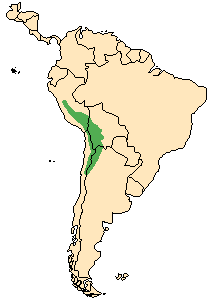![]() Return
to Artiodactyla
Return
to Artiodactyla
Classification
|
 Vicugna
vicugna
Vicugna
vicugna
Vicuña
![]()
Taxonomy
 |
 |
 |
Click on the pictures above for a larger view of the
photographs
|
||
General Characteristics
Body Length: 138-151 cm / 4.6-5 ft.
Shoulder Height: 86-96 cm / 2.8-3.2 ft.
Tail Length: 23 cm / 9.2 in.
Weight: 45-55 kg / 99-121 lb.The overall colour of the soft wooly coat is ochre, light cinnamon, or reddish brown, with the underparts, insides of the legs, and underside of the head being dirty white. On the chest, at the base of the neck, is a peculiar, pompon-like 'mane' of silky white hairs which may be 20-30 cm / 8-12 inches in length. The vicuña is extremely slender, with long skinny limbs and neck. The head is small and wedge shaped, with small, triangular ears. Unique among living artiodactyls, the incisors of the vicuña are constantly growing, with enamel on only one side, to keep up with the wear caused by the tough grasses on which they feed.
Ontogeny and Reproduction
Gestation Period: 330-350 days.
Young per Birth: 1
Weaning: At 6-8 months.
Sexual Maturity: Around 24 months.
Life span: 20 years, maximum age of 24 years, 9 months in captivity.In the wild, breeding occurs in March/April, with births taking place in February and March. Just 15 minutes after birth the young can stand and walk.
Ecology and Behavior
A principally diurnal species, vicuñas have a unique system of territoriality. A day-time territory is used for grazing, and is connected to a higher sleeping territory by an undefended corridor. Together, the two territories cover 7-30 hectares, marked by dung heaps. Families are close-knit, with the dominant male keeping individuals within 50 meters / 160 feet of each other at all times. In addition, these family groups are closed - with immigration virtually eliminated by the dominant male. Juveniles of both sexes are evicted from the group by the reigning male - young males at 4-9 months, and females at 10-11 months of age. Communal latrines are used by each family group. Very shy and constantly alert, vicuñas will flee at the slightest sign of danger. They can run at nearly 50 kmph / 30 mph at elevations of 4,500 meters / 15,000 feet, aided by a heart which is almost 50% larger than the average weight for similar sized mammals. The warning call is a high soprano whistle. Vicuñas must drink daily - an important factor used when determining a family's range.Family group: Families of 5-20 animals with a single adult male, several females, and youngsters. All-male bachelor herds and solitary males are also known.
Diet: Grasses.
Main Predators: Humans, puma, Magellan fox.
Distribution
Grasslands at elevations of 3,500-5,800 meters / 11,700-19,300 feet in the Andes mountains of Peru, Bolivia, Argentina, and Chile.

Range Map (Redrawn from CITES, 2000)
Conservation Status
The vicuña is a low risk, conservation dependent species (IUCN, 1996). The two subspecies, V. v. mensalis and V.v. vicugna both fall under this same threat category.
Remarks
The genus Vicugna was once included in Lama. The vicuña, the smallest of the camelids, have had an interesting relationship with humans over time. In their time, the Incas would round up wild vicuñas every 3 to 5 years to shear them, releasing them afterwards, and using the soft wool to make fabrics for nobility. With the conquest of Peru, the wool and hide of the vicuña became highly desired by the Spanish, and more than 80,000 vicuñas were slaughtered annually. When liberation from Spanish rule came in 1825, vicuñas became a symbol in Peru and was protected by law. Poaching, however, continued well into the 20th Century, when several preserves were set aside for these remarkable ungulates. Vicuña is a Peruvian name for this tylopod.
Literature Cited
CITES. 2000. Proposal 11.27: Transfer of all populations of vicuña Vicugna vicugna from Appendix I. Available online at http://www.cites.org/eng/cop/11/prop/27.pdfFranklin, W. L. and W. Herre. 1990. South American Tylopods. In Grzimek's Encyclopedia of Mammals. Edited by S. P. Parker. New York: McGraw-Hill. Volume 5, pp. 96-111.
Nowak, R. M. [editor]. 1991. Walker's Mammals of the World (Fifth Edition). Baltimore: The Johns Hopkins University Press.
Wilson, D. E., and D. M. Reeder [editors]. 1993. Mammal Species of the World (Second Edition). Washington: Smithsonian Institution Press. Available online at http://nmnhwww.si.edu/msw/
Return to Artiodactyla

![]()
© Brent Huffman, www.ultimateungulate.com |
|